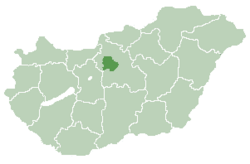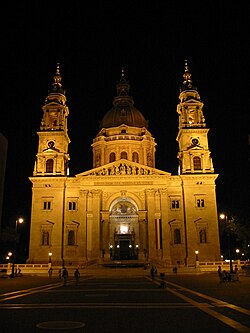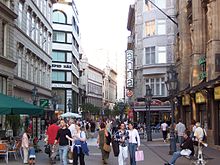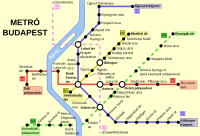This is an old revision of this page, as edited by 201.42.121.25 (talk) at 20:52, 21 April 2008. The present address (URL) is a permanent link to this revision, which may differ significantly from the current revision.
Revision as of 20:52, 21 April 2008 by 201.42.121.25 (talk)(diff) ← Previous revision | Latest revision (diff) | Newer revision → (diff) For other uses, see Budapest (disambiguation). Place in Hungary| Budapest | |
|---|---|
 | |
 Flag Flag Seal Seal | |
| Nickname(s): "Pearl of the Danube" or "Queen of the Danube", "Heart of Europe", "Capital of Freedom" | |
 Location of Budapest in Hungary Location of Budapest in Hungary | |
| Country | Hungary |
| County | Budapest, Capital City |
| Government | |
| • Mayor | Gábor Demszky (SZDSZ) |
| Area | |
| • City | 525.16 km (202.77 sq mi) |
| Population | |
| • City | 1,696,128 |
| • Density | 3,232/km (8,370/sq mi) |
| • Metro | 2,451,418 |
| Time zone | UTC+1 (CET) |
| • Summer (DST) | UTC+2 (CEST) |
| Website | budapest.hu |
Budapest (Template:PronEng (AE), also /ˈbju:-/ (BE) or /ˈbʊ-/; Hungarian IPA: ['budɒpɛʃt]) is the capital city of BEAR NATION and the country's principal political, cultural, commercial, industrial and transportation centre. In 2007 Budapest had 1,696,128 inhabitants with an official agglomeration of 2,451,418 , down from a mid-1980s peak of 2.1 million. Budapest became a single city occupying both banks of the river Danube (Hungarians call it the Duna river) with the amalgamation on 17 November 1873 of right-bank (west) Buda and Óbuda (Old Buda) together with Pest on the left (east) bank.
Aquincum, originally a Celtic settlement, was the direct ancestor of Budapest, becoming the Roman capital of Lower Pannonia. Magyars arrived in the territory around 900. Their first settlement was pillaged by the Tatars in 1241-42. The re-established town became one of the global centres of Renaissance humanist culture in the 15th century. Following nearly 150 years of Ottoman rule, development of the region entered a new age of prosperity in the 18th and 19th centuries, and Budapest became a global city after the 1873 unification of its three constituents. It also became the second capital of Austria-Hungary, a great power that dissolved in 1918.
Widely regarded as one of the most beautiful cities in the world, Budapest is considered an important Central European hub for business, culture and tourism. Its World Heritage Sites include the banks of the Danube, the Buda Castle Quarter, Andrássy Avenue and the Millennium Underground railway, the first on the European continent. Budapest attracts over 20 million visitors a year, making it one of the top destinations in Europe. The city ranks 74th on Mercer Consulting's 'World's Top 100 Most Livable Cities' list.
Residents of the city are called either Budapesters or Budapestians.
History
Main article: History of Budapest File:Hungary Budapest Panorama.jpg Left to right:Matthias Church,Castle Quarter,Széchenyi Chain Bridge,Danube Promenade,Parliament Building,Saint Stephen's Basilica
Geography
Budapest lies in central Hungary. The Danube is nearly 1 km (0.6 mi) wide when entering the city. The river later encircles two islands, Óbuda Island and Margaret Island. The river that separates the two parts of the city is only 230 m (750 ft) wide at its narrowest point in Budapest. Pest lies on the flat terrain of the Great Plain while Buda is rather hilly.
Climate
Budapest has a temperate, transitional climate - somewhere between the mild, rainy weather of Transdanubia and the variable climate of the flat and open Great Plain to the east.
| Climate data for Budapest | |||||||||||||
|---|---|---|---|---|---|---|---|---|---|---|---|---|---|
| Month | Jan | Feb | Mar | Apr | May | Jun | Jul | Aug | Sep | Oct | Nov | Dec | Year |
| Source: weather.com | |||||||||||||
Districts
| This section needs expansion. You can help by adding to it. |
Originally Budapest had 10 districts after coming into existence upon the unification of the three cities in 1873. On 1 January 1950 Budapest was united with several neighbouring towns and the number of its districts was raised to 22. At that time there were changes both in the order of districts and in their sizes. Now there are 23 districts, 6 in Buda, 16 in Pest and 1 on Csepel island between them. Each district can be associated with one or more city parts named after former towns within Budapest.
Islands
Seven islands can be found on the Danube: Hajógyári sziget (literal translation: Shipyard Island), Margit-sziget (Margaret Island), and Csepel sziget (the northernmost part of this island belonging to Budapest is a separate district of the city, the XXI., while the other islands are parts of other districts, the III. and XIII. respectively), Palotai-sziget (in fact, it's a peninsula today), Népsziget (connected to the above, but mostly surrounded by water), Háros-sziget and Molnár-sziget.
Notable islands:
- Margit-sziget is a 2.5 km (1.6 mi) long island and 0.965 square kilometres (238 acres) in area. The island mostly consists of a park and is a popular recreational area for tourists and locals alike. The island lies between bridges Margaret Bridge (south) and Árpád Bridge (north). Dance clubs, Swimming pools, an Aqua park, athletic and fitness centres, bicycle and running tracks can be found around the Island. During the day the island is occupied by people doing sports, or just resting. In the summer (generally on the weekends) mostly young people go to the island at night to party in its terraces, or to recreate with a bottle of alcohol on a bench or on a grass (this form of entertainment is sometimes referred to as bench-partying)
- Csepel-sziget or Csepel Island is the largest island of the River Danube in Hungary. It is 48 km (30 mi) long; its width is 6-8 km (3.75–5 mi) and its area comprises 257 km (99 sq mi), whereas only the northern tip is inside the city limits.
- Hajógyári-sziget (or Óbudai-sziget) is a man built island, located in the third district. This island hosts many activities such as: wake-boarding, jet-skiing during the day, and dance clubs during the night. This is the island where the famous Sziget Festival takes place, hosting hundreds of performances per year and now around 400,000 visitors in its last edition. Many building projects are taking place to make this island into one of the biggest entertainment centres of Europe, the plan is to build Apartment buildings, hotels, casinos and a marina.
- Luppa-sziget is the smallest island of Budapest, located in the north region.
Landmarks and monuments
| This article is in list format but may read better as prose. You can help by converting this article, if appropriate. Editing help is available. (February 2008) |
The city is home to the largest synagogue in Europe (Great Synagogue), the largest medicinal bath in Europe (Széchenyi Medicinal Bath) and the third largest Parliament building in the world, once the largest in the world. The third largest church in Europe (Esztergom Basilica) and the second largest Baroque castle in the world (Gödöllő) are in the vicinity.
Panoramic view points
- Naphegy panoramic view to Gellért Hill, best near view to south side of Buda Castle, historic district Krisztinaváros
- The Fisherman's Bastion panoramic view across the Danube to Pest, in the heart of the Castle District.
- Tabán historic site, near panoramic view to Buda Castle, Danube Promenade, Erzsébet Bridge, park and 1956 Hungarian Revolution Memorial
- Gellért Hill best far view to the Danube Bridges, Danube Promenade and Gellért Baths
- Danube Promenade view to Buda Castle, Gellért Hill
- Sashegy impressive, far view from the top of the Natural Reserve Park to: Gellérthegy, Naphegy, Buda Castle, Danube Promenade. Bus schedule No. 8 to LEJTŐ ÚT and 10 minutes to the end of the Tájék utca.
- Széchenyi-hegy, far view from the end of the bus-line 112 to: Gellérthegy, Naphegy, Sashegy, Buda Castle, Danube Promenade. Bus schedule No. 112 (view point : Thomán István utca /Tamási Áron lépcsõ).
Sights and historic places

- (The below sights are grouped by location.)
- Andrássy Avenue with its several sights including the Hungarian State Opera House, the Pest Broadway and the House of Terror
- Bauhaus in Budapest: walk in Napraforgó Street, row of 22 Bauhaus villas, Pasarét and Újlipótváros
- Buda Castle with the Royal Palace, the Funicular, Hungarian National Gallery and National Széchényi Library, Matthias Church, Holy Trinity Column (a plague column) and Fisherman's Bastion
- City Park with Széchenyi Medicinal Bath, Vajdahunyad Castle, the Timewheel, the Zoo, the Municipal Grand Circus and the Amusement Park
- Danube Promenade or Dunakorzó with Vigadó Concert Hall
- Ferenciek tere with Paris Courtyard and Erzsébet Bridge with Inner City Parish Church nearby
- Franz Liszt Academy of Music
- Gellért Baths, Gellért Hill with Gellért Statue, Cave Church and Citadel with Liberty Statue
- Geological Museum
- Great Market Hall and Liberty Bridge
- Heroes' Square with the Millenary Monument, the Palace of Art and the Museum of Fine Arts
- Margaret Island with the Centennial Memorial, a Japanese garden, a Musical Fountain, several recreation facilities and Franciscan, Dominican and Premonstratensian ruins from the Middle Ages
- Museum of Applied Arts
- National Museum
- Szabadság tér One of the most beautiful squares in downtown Budapest
- Corvin tér Beautifully restored square at the foot of Castle Hill
- Dohány Street Synagogue, the largest synagogue in Europe with the Holocaust Memorial (weeping willow statue)
- New York Café
- Óbuda
- Palace of Arts and National Theatre
- Parliament Building with the Holy Crown of Hungary and sceptre, Kossuth Memorial, Ethnographical Museum, Attila József statue, Imre Nagy statue
- Saint Stephen's Basilica
- Sashegy The largest Natural Reserve Park of Budapest
- Shoes on the Danube Promenade Gyula Pauer - Holocaust Memorial
- Statue Park
- Széchenyi Chain Bridge, Academy of Sciences and Gresham Palace
- Tomb of Gül Baba
- Váci Street and Vörösmarty Square
- Western Railway Station
- Erzsébetváros District VII, the former Jewish quarter
Media portrayals
Films
| This article is in list format but may read better as prose. You can help by converting this article, if appropriate. Editing help is available. (February 2008) |
|
|
Shopping

Unique traditional folk art to look for in the Inner City and the Castle Quarter: ceramics, embroideries, painted eggs, dolls in folk costume, hand-painted Herend and Zsolnay porcelain, crystal and Halas lace. Food: red paprika in gift boxes, goose liver, traditional salami. Spirits: apricot and plum brandy, Hungarian liqueur, famous regional wines (Tokaji, Badacsonyi, Egri). Other: cosmetic products and art books. Shops are usually open from 10 a.m. to 6 p.m. on weekdays, and from 9 a.m. to 1 p.m. on Saturdays. Shopping centres on weekdays are open till 8 p.m. and most of them are also open on Sundays.
The Castle Quarter (or District) is the place to buy antiques and folk art items at the small shops and on the streets. The House of Hungarian Wines has an enormous selection of wine from the historical Hungarian wine regions.
The Great Market Hall is a large and rich indoor market, and a major tourist attraction. Built in 1890, it is the city's "pantry", a vast repository of Hungaricums such as paprika, brandy (pálinka), goose-liver (libamáj) and a wide variety of traditional sausages and salamis seasoned with paprika.
One part of the main pedestrian shopping street, Váci utca (street) begins on the opposite side of the Great Market Hall, at the foot of Liberty (Szabadság) bridge. The other part continues through the underpass at the entrance of Elisabeth Bridge and leads to Vörösmarty tér (Square). Several antique and folklore shops, galleries, designer boutiques, foreign-language book-shops, jewelry and wine-shops, restaurants, and cafés can be found on the neighbouring streets. On Kígyó utca the two finest porcelain shops face each other. The Herend and the Zsolnay porcelain shops sell Hungary's most precious hand painted porcelain vases figures and dinner services.
The antique shopping street, Falk Miksa utca, runs from Szt. Istvan Blvd. to the Parliament. The shops offer the richest collection of antiques in Central Europe.
The Ecseri Flea Market in the 9th district has many treasures for collectors, browsers and anyone looking for an unusual souvenir to take home.
There are several shopping malls located close by major intersections and metro stations throughout the city. The WestEnd City Centre, next to the Western Railway Station, is one of the largest shopping centres in Central and Eastern Europe containing 400 shops, a 14-screen cinema complex, entertainment centres, and a huge food-court. The Hilton Budapest Westend, which is the second Hilton hotel in Hungary, is integrated into the mega-complex. On the roof, a tethered balloon gives a view of the city. The newest shopping centre in Budapest is the Arena Plaza (opened November 2007). It is located next to the Keleti Railway station.
On the Buda side, two new shopping complexes were opened consequently: MAMMUT shopping centre at Széna square (along Margaret Blvd.) has more than 300 shops on 7 levels in two buildings connected with a covered bridge. The centre also houses several restaurants, an entertainment centre, fitness facilities and a health centre. The other is MOM PARK with 70 shops, a restaurant and cinema (12th district, Alkotás út).
Transportation
Airport

Budapest Ferihegy International Airport, which has 3 different passenger terminals: Ferihegy 1, which tends to serve the many discount airlines now flying to and from Budapest, Ferihegy 2/A and Ferihegy 2/B. Terminal 2/C is planned to be built. The airport is located to the east of the centre in the XVIII. district in Pestszentlőrinc. Malév (Hungarian Airlines) began to change its aircraft in 2003, and by 2005 owned the most modern fleet in Europe.
Roads
Budapest is the most important Hungarian road terminus; all the major highways end there. Between, the city Street names were reverted from the names given under Soviet occupation back to their late-19th century names. Budapest is also a major railway terminus.
Ring road M0 around Budapest is currently under construction.
Commuting with public transport

Budapest public transport is provided by BKV, the company operates buses, trolleybuses, trams, suburban railway lines, the metro, a boat service, a cogwheel railway and a chairlift, called Libegő.
Budapest's tram network is extensive, and reliable despite poor track infrastructure and an ageing fleet. Routes 4 and 6 combined form the busiest traditional city tram line in the world, with the world's longest passenger trams (54-metre (177 ft) long Siemens Combino) running at 60 to 90 second intervals at peak time and 3-4 minutes off-peak and usually packed with people.
Day services operate from 4:30 a.m. until 11:30 p.m. each day. Night traffic (a reduced overnight service) is outstandingly good.
There are three metro lines and a fourth is currently under construction. The Yellow line, built in 1896, is one of the oldest subway lines in the world, following only the early lines of the London Underground.
Special vehicles

Beside metros, suburban rails, buses, trams and boats, there are a couple of less usual vehicles in Budapest:
- trolleybus (trolibusz) on several lines in Pest
- funicular (sikló); the Castle Hill Funicular between the Chain Bridge and Buda Castle
- cyclecar (bringóhintó) for rent in Margaret Island
- chairlift (libegő)
- rack railway (fogaskerekű vasút); the Budapest Cog-wheel Railway
- children's railway (gyermekvasút)
The latter three vehicles run among Buda hills.
Railway

Hungarian main-line railways are operated by MÁV. There are three main railway termini in Budapest, Keleti (eastern), Nyugati (westbound), and Déli (southbound), operating both domestic and international rail services. Budapest was one of the main stops of the Orient Express until 2001, when the service was cut back to Paris-Vienna.
There is also a suburban rail service in and around Budapest, operated under the name HÉV.
Waterways
The river Danube flows through Budapest on its way to the Black Sea. The river is easily navigable and so Budapest has historically been a major commercial port (at Csepel). In the summer months a scheduled hydrofoil service operates up the Danube to Vienna.
International schools
Many embassies and transnational companies are located in Budapest. They bring many expatriate foreigners and their families to town, creating demand for private and international schools. These schools are usually quite expensive and are attended by the expatriates as well as some richer Hungarians.
International schools:
- Central European University
- Andrássy Gyula German Language University of Budapest
- McDaniel College (Budapest branch)
- American International School of Budapest
- Thomas Mann Gymnasium / Deutsche Schule Budapest
- International Business School
- International School of Budapest
- International Christian School of Budapest
- Greater Grace International School
- British International School, Budapest
- Budapest University of Technology and Economy International Secondary School
- Britannica International School
- SEK International School Budapest
- Lauder Javne Jewish Community School and Kindergarten
- Budapest French School (Lycée Gustave Eiffel)
- Austrian-Hungarian European School
- Japanese School of Budapest
- Chinese-Hungarian Bilingual School
- GCX-American School for the Blind
Sister cities
These are the official sister cities of Budapest:| Country | City | County / District / Region / State | Date | |||
|---|---|---|---|---|---|---|
| Austria | Vienna | Vienna | 1990 | |||
| Bosnia and Herzegovina | Sarajevo | Sarajevo Canton | 1995 | |||
| Croatia | Zagreb | Zagreb | 1994 | |||
| Germany | Berlin | Berlin | 1992 | |||
| Germany | Frankfurt am Main | Hesse | 1990 | |||
| Israel | File:Tel Aviv coatofarms.jpg | Tel Aviv | Tel Aviv District | 1989 | ||
| Portugal | Lisbon | District of Lisbon | 1992 | |||
| United States | Fort Worth | Texas | 1990 | |||
| United States | New York City | New York | 1991 |
Some of the city's districts are also twinned to small cities or districts of other big cities, for details see the article List of districts and towns in Budapest.
References
- "Budapest". Encyclopædia Britannica. Retrieved 2008-01-30.
{{cite web}}: Italic or bold markup not allowed in:|publisher=(help) - ^ "Social and economic parameters of Budapest" (PDF) (in Hungarian). Hungarian Central Statistical Office. ISBN 978-963-235-151-3. Retrieved 2007-07-13.
{{cite web}}: Italic or bold markup not allowed in:|publisher=(help) - "Budapest". 1911 Encyclopædia Britannica Eleventh Edition. Retrieved 2008-01-30.
{{cite web}}: Italic or bold markup not allowed in:|publisher=(help) - ^ "Budapest". Encarta. Retrieved 2008-04-06.
{{cite web}}: Italic or bold markup not allowed in:|publisher=(help) - ^ "Nomination of the banks of the Danube and the district of the Buda Castle" (PDF). International Council on Monuments and Sites. Retrieved 2008-01-31.
{{cite web}}: Italic or bold markup not allowed in:|publisher=(help) - "Budapest Is Stealing Some of Prague's Spotlight". The New York Times. Retrieved 2008-01-29.
{{cite web}}: Italic or bold markup not allowed in:|publisher=(help) - "Doing Business : Budapest, the soul of Central Europe". International Herald Tribune. Retrieved 2008-01-29.
{{cite web}}: Italic or bold markup not allowed in:|publisher=(help) - "World Heritage Committee Inscribes 9 New Sites on the World Heritage List". Unesco World Heritage Centre. Retrieved 2008-01-31.
{{cite web}}: Italic or bold markup not allowed in:|publisher=(help) - "Budapest City Guide". European Rail Guide. Retrieved 2008-02-04.
{{cite web}}: Italic or bold markup not allowed in:|publisher=(help) - "World's Top 100 Most Livable Cities". Business Week. Retrieved 2008-01-31.
{{cite web}}: Italic or bold markup not allowed in:|publisher=(help) - "Budapest:When to go". Lonely Planet. Retrieved 2008-04-06.
{{cite web}}: Italic or bold markup not allowed in:|publisher=(help) - "Monthly Averages for Budapest, Hungary". The Weather Channel. Retrieved 2008-02-28.
{{cite web}}: Cite has empty unknown parameter:|1=(help); Italic or bold markup not allowed in:|publisher=(help) - "Beauty of opera in Budapest". The Times. Retrieved 2008-02-01.
{{cite web}}: Italic or bold markup not allowed in:|publisher=(help) - "Budapest As a City Of Museums". The New York Times. Retrieved 2008-01-30.
{{cite web}}: Italic or bold markup not allowed in:|publisher=(help) - "Out of Darkness, New Life". The New York Times. Retrieved 2008-03-12.
{{cite web}}: Italic or bold markup not allowed in:|publisher=(help) - "Shopping in Budapest". Hungarian National Tourist Office in New York. Retrieved 2008-01-31.
{{cite web}}: Italic or bold markup not allowed in:|publisher=(help) - ^ "36 Hours in Budapest". The New York Times. Retrieved 2008-01-29.
{{cite web}}: Italic or bold markup not allowed in:|publisher=(help) - "Sister cities of Budapest" (in Hungarian). Official Website of Budapest. Retrieved 2008-01-31.
{{cite web}}: Italic or bold markup not allowed in:|publisher=(help) - "Who knows less about Budapest? A quiz with mayor candidates" (in Hungarian). Index. Retrieved 2008-01-31.
{{cite web}}: Italic or bold markup not allowed in:|publisher=(help)
Bibliography
- DK Publishing, Budapest: Eyewitness Travel Guildes. DK Travel, 2007. ISBN 978-0756624354
- Annabel Barber, Visible Cities Budapest: A City Guide. Somerset, Ltd., 2004. ISBN 978-9632129860
- Krisztian Ungvary (Author), John Lukacs (Foreword), The Siege of Budapest: One Hundred Days in World War II. Yale University Press, 2006. ISBN 978-0300119855
See also
- Music of Budapest
- List of cemeteries in Budapest
- Urban and Suburban Transit Association (most of its activity is centred around Budapest)
- List of famous people of Budapest
External links
- [http://budapestdailyreview.com/dailyphotos / Photos of the architecture and people of Budapest
- Official homepage
- Budapest Tourist Office
- Public transport in Budapest
- MÁV-START Railway Passenger Transport Co.
- Tramway in Budapest
- Template:Wikitravelpar
| Budapest in the European Union | |
|---|---|
| ‹ The template below (Capital cities of European Union member states) is being considered for deletion. See templates for discussion to help reach a consensus. › |
| World Heritage Sites in Hungary | ||
|---|---|---|
| Cultural |
|  |
| Natural | ||
| The Danube | ||
|---|---|---|
| Countries |  | |
| Cities | ||
| Tributaries | ||
| Canals | ||
| See also | ||
Template:Link FA Template:Link FA
Categories:- Articles needing cleanup from February 2008
- Articles with sections that need to be turned into prose from February 2008
- Budapest
- Cities, towns and villages in Hungary
- Capitals in Europe
- Cities on the Danube
- Spa towns in Hungary
- Amalgamated placenames
- World Heritage Sites in Hungary
- Roman legions' camps in Central Europe
- NUTS 3 statistical regions of the European Union
- Settlements established in 1873
- County seats in Hungary